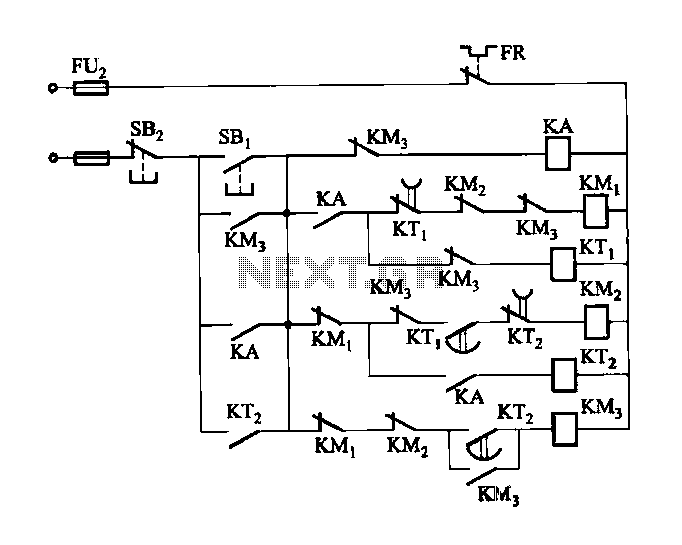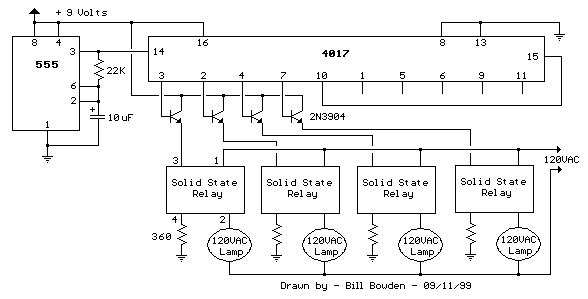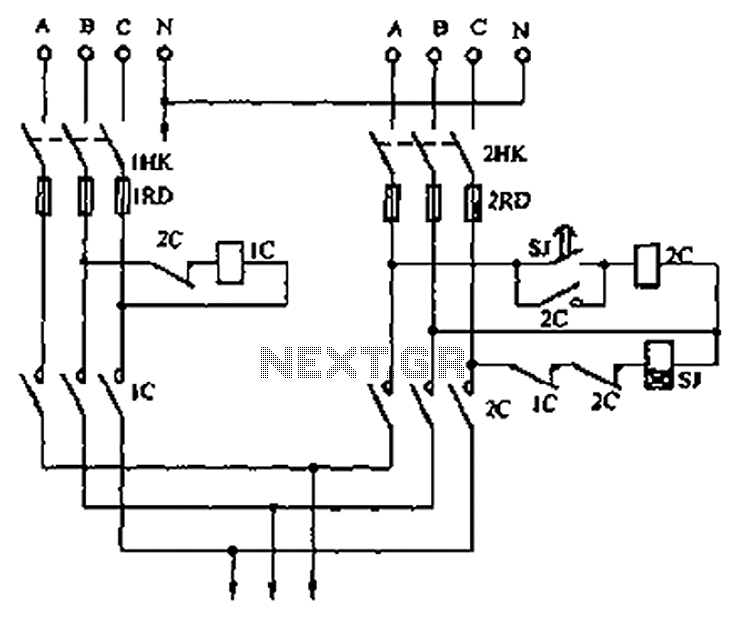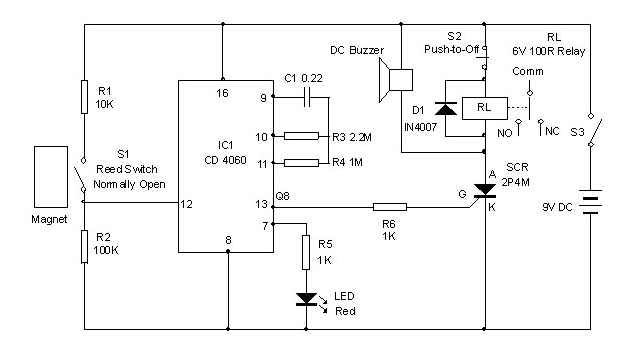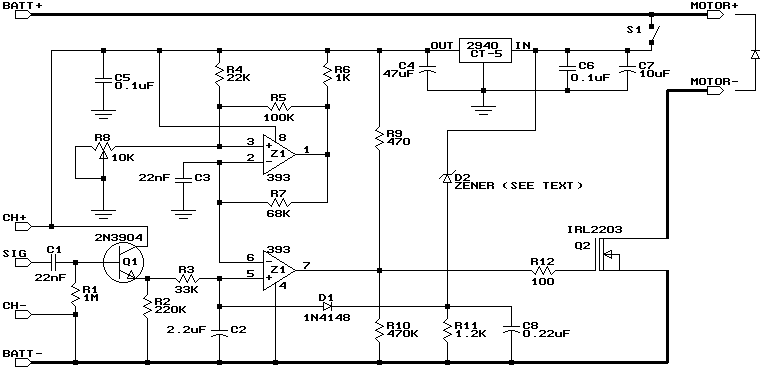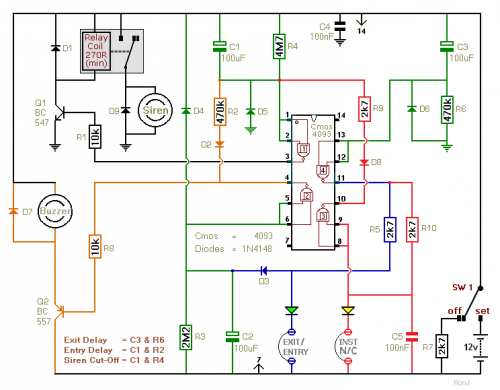
Car Speed Alarm Schematic
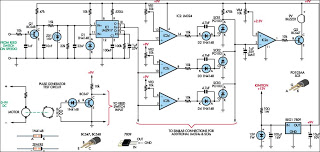
When driving, it can be difficult to gauge the speed of a vehicle, particularly on straight highways. If the vehicle exceeds a safe speed, it may lead to accidents. Therefore, a Car Speed Alarm circuit is necessary to alert drivers who may not be aware of their speed due to the road conditions. This circuit allows the user to set a specific speed threshold, such as 100 km/h, at which point the alarm will sound. The operation of the circuit involves a piezo buzzer that activates upon detecting speed pulses. These pulses are sent to the base of transistor Q1, and the resulting waveform at the collector is processed through an RC network to the input of an LM2917 frequency-to-voltage converter, labeled IC1. The output voltage is then sent to three comparators (IC2d-IC2b) that have reference voltages set by 10-turn trimpots VR1, VR2, and VR3 at their inverting inputs. The output from each comparator is routed through another RC network to the gate of a Silicon Controlled Rectifier (SCR). The anodes of the three SCRs are connected together, with the inverting input of comparator IC2a linked to the left. The non-inverting input is set to 2.3 V using trimpot VR4. When the vehicle exceeds the set speed for a specific comparator, the corresponding SCR momentarily pulls pin 2 of IC2a low, resulting in a short beep from the piezo buzzer. If the speed exceeds the next threshold, an additional beep will sound. The design ensures that each speed setting is slightly higher than the actual speed, allowing drivers to maintain the correct speed without the buzzer sounding unnecessarily. This functionality enables drivers to ignore beeps that do not indicate illegal speeds.
The Car Speed Alarm circuit is an essential tool for enhancing driving safety by providing audible alerts when speed limits are exceeded. The design incorporates several key components that work together to achieve this goal. The heart of the circuit is the LM2917 frequency-to-voltage converter, which accurately translates the frequency of speed pulses into a proportional voltage. This voltage is then compared against preset thresholds established by the adjustable trimpots, allowing for customization according to local speed limits.
The use of comparators allows for multi-threshold detection, enabling the circuit to provide distinct alerts for different speed ranges. The SCRs serve as electronic switches that activate the buzzer, ensuring that the alerts are both timely and effective. The RC networks are critical for filtering and smoothing the signals, preventing false alarms and ensuring reliable operation.
The piezo buzzer chosen for this application is effective in producing clear, audible tones that can be heard over road noise, making it an ideal choice for automotive applications. The design's flexibility, including the ability to set multiple speed thresholds, offers a user-friendly approach to speed monitoring without the need for constant adjustments.
Overall, the Car Speed Alarm circuit exemplifies a practical application of electronic components in enhancing vehicle safety, promoting responsible driving habits, and reducing the likelihood of speed-related accidents.When we are driving sometimes we do not know the speed of our car, especially when we are in the course of the highway so nice and straight, if the cars speed is too fast or faster than anyone could lead to accidents that do not want to happen. The circuit then requires the Car Speed Alarm is to alert the driver who did not notice the speed becaus
e the roads are nice and straight. Even this series can be set speed, for example, we set when exceeded 100km/h the alarm should sound. The workings of the circuit:A piezo buzzer will sound. Speed pulse is inserted into the base of Q1 and the resulting waveform at the collector is fed through a RC network to the input of an LM2917 frequency to voltage converter, IC1. The resulting voltage is fed to three comparators (IC2d-IC2b) which has a reference voltage at the inverting input they are set by the 10-turn trimpots VR1, VR2 and VR3.
The output of each comparator is applied through another RC network to the gate of an SCR. Anode of the three SCRs are commoned comparator inverting input connected to the left, IC2a. Non-inverting input is set to 2. 3 V with a trimpot VR4. In use, once you exceed the speed setting for the comparator in particular, relating SCR to briefly pull the pin 2 of IC2a low and short beep is emitted by a piezo buzzer. Then, if you exceed the speed setting that followed, another beep will be heard. The idea is to make each setting speed of several km / h higher than it actually is, so if you are driving at the correct speed in a particular zone, the buzzer will not sound.
But as you increase speed, the buzzer will beep once because you exceed the speed settings for each zone. In this way, there is no need to constantly switch setting the pace as you pass through different zones and you can choose to ignore the beep is not "illegal".
🔗 External reference
The Car Speed Alarm circuit is an essential tool for enhancing driving safety by providing audible alerts when speed limits are exceeded. The design incorporates several key components that work together to achieve this goal. The heart of the circuit is the LM2917 frequency-to-voltage converter, which accurately translates the frequency of speed pulses into a proportional voltage. This voltage is then compared against preset thresholds established by the adjustable trimpots, allowing for customization according to local speed limits.
The use of comparators allows for multi-threshold detection, enabling the circuit to provide distinct alerts for different speed ranges. The SCRs serve as electronic switches that activate the buzzer, ensuring that the alerts are both timely and effective. The RC networks are critical for filtering and smoothing the signals, preventing false alarms and ensuring reliable operation.
The piezo buzzer chosen for this application is effective in producing clear, audible tones that can be heard over road noise, making it an ideal choice for automotive applications. The design's flexibility, including the ability to set multiple speed thresholds, offers a user-friendly approach to speed monitoring without the need for constant adjustments.
Overall, the Car Speed Alarm circuit exemplifies a practical application of electronic components in enhancing vehicle safety, promoting responsible driving habits, and reducing the likelihood of speed-related accidents.When we are driving sometimes we do not know the speed of our car, especially when we are in the course of the highway so nice and straight, if the cars speed is too fast or faster than anyone could lead to accidents that do not want to happen. The circuit then requires the Car Speed Alarm is to alert the driver who did not notice the speed becaus
e the roads are nice and straight. Even this series can be set speed, for example, we set when exceeded 100km/h the alarm should sound. The workings of the circuit:A piezo buzzer will sound. Speed pulse is inserted into the base of Q1 and the resulting waveform at the collector is fed through a RC network to the input of an LM2917 frequency to voltage converter, IC1. The resulting voltage is fed to three comparators (IC2d-IC2b) which has a reference voltage at the inverting input they are set by the 10-turn trimpots VR1, VR2 and VR3.
The output of each comparator is applied through another RC network to the gate of an SCR. Anode of the three SCRs are commoned comparator inverting input connected to the left, IC2a. Non-inverting input is set to 2. 3 V with a trimpot VR4. In use, once you exceed the speed setting for the comparator in particular, relating SCR to briefly pull the pin 2 of IC2a low and short beep is emitted by a piezo buzzer. Then, if you exceed the speed setting that followed, another beep will be heard. The idea is to make each setting speed of several km / h higher than it actually is, so if you are driving at the correct speed in a particular zone, the buzzer will not sound.
But as you increase speed, the buzzer will beep once because you exceed the speed settings for each zone. In this way, there is no need to constantly switch setting the pace as you pass through different zones and you can choose to ignore the beep is not "illegal".
🔗 External reference
